 Yamaha aerox NS50 - Owner's Manual > Changing the coolant
Yamaha aerox NS50 - Owner's Manual > Changing the coolant
The coolant must be changed at the intervals specified in the periodic maintenance and lubrication chart. Have a Yamaha dealer change the coolant.
WARNING! Never attempt to remove the radiator cap when the engine is hot.
Cleaning the air filter element
The air filter element should be cleaned at the intervals specified in the periodic maintenance and lubrication chart.
Clean the air filter element more frequently if you are riding in unusually wet or dusty areas.
1. Remove the air filter case cover by removing the screws.

- Screw
2. Pull the air filter element out, clean it with solvent, and then squeeze the remaining solvent out.
WARNING! Use only a dedicated parts cleaning solvent. To avoid the risk of fire or explosion, do not use gasoline or solvents with a low flash point.
NOTICE: To avoid damaging the foam material, handle it gently and carefully, and do not twist or wring it.

- Air filter element
3. Apply oil of the recommended type to the entire surface of the element, and then squeeze the excess oil out.

TIP
The air filter element should be wet but not dripping.
Recommended oil: Foam air filter oil
4. Insert the element into the air filter case.
NOTICE: Make sure that the air filter element is properly seated in the air filter case. The engine should never be operated without the air filter element installed, otherwise the piston( s) and/or cylinder(s) may become excessively worn.
5. Install the air filter case cover by installing the screws.
Adjusting the carburetor
The carburetor is an important part of the engine and requires very sophisticated adjustment. Therefore, all carburetor adjustments should be left to a Yamaha dealer, who has the necessary professional knowledge and experience.
Checking the throttle grip free play

1. Throttle grip free play
The throttle grip free play should measure 3.0-5.0 mm (0.12-0.20 in) at the inner edge of the throttle grip. Periodically check the throttle grip free play and, if necessary, have a Yamaha dealer adjust it.
Tires
Tires are the only contact between the vehicle and the road. Safety in all conditions of riding depends on a relatively small area of road contact. Therefore, it is essential to maintain the tires in good condition at all times and replace them at the appropriate time with the specified tires.
Tire air pressure

The tire air pressure should be checked and, if necessary, adjusted before each ride.
WARNING
Operation of this vehicle with improper tire pressure may cause severe injury or death from loss of control.
- The tire air pressure must be checked and adjusted on cold tires (i.e., when the temperature of the tires equals the ambient temperature).
- The tire air pressure must be adjusted in accordance with the riding speed and with the total weight of rider, passenger, cargo, and accessories approved for this model.
Tire air pressure (measured on cold tires): 0-90 kg (0-198 lb): Front: 180 kPa (1.80 kgf/cm², 26 psi) Rear: 200 kPa (2.00 kgf/cm², 29 psi) 90-185 kg (198-408 lb): Front: 190 kPa (1.90 kgf/cm², 28 psi) Rear: 220 kPa (2.20 kgf/cm², 32 psi) Maximum load*: 185 kg (408 lb) * Total weight of rider, passenger, cargo and accessories
WARNING
Never overload your vehicle. Operation of an overloaded vehicle could cause an accident.
Tire inspection

- Tire tread depth
- Tire sidewall
The tires must be checked before each ride. If the center tread depth reaches the specified limit, if the tire has a nail or glass fragments in it, or if the sidewall is cracked, have a Yamaha dealer replace the tire immediately.
Minimum tire tread depth (front and rear): 1.6 mm (0.06 in)
TIP
The tire tread depth limits may differ from country to country. Always comply with the local regulations.
Tire information
This model is equipped with tubeless tires.
Tires age, even if they have not been used or have only been used occasionally.
Cracking of the tread and sidewall rubber, sometimes accompanied by carcass deformation, is an evidence of ageing. Old and aged tires shall be checked by tire specialists to ascertain their suitability for further use.
After extensive tests, only the tires listed below have been approved for this model by Yamaha Motor Co., Ltd.
Front tire: Size: 120/70-13 53P(Michelin) 53L(SAVA, Metzeler)
Manufacturer/model: MICHELIN/POWER PURE SC SAVA/ MC 16
METZELER/ ME 7 TEEN
Rear tire: Size: 140/60-13 57P(Michelin) 57L(SAVA, Metzeler)
Manufacturer/model: MICHELIN/POWER PURE SC SAVA/ MC 16
METZELER/ ME 7 TEEN
WARNING
- Have a Yamaha dealer replace excessively worn tires. Besides being illegal, operating the vehicle with excessively worn tires decreases riding stability and can lead to loss of control.
- The replacement of all wheel and brake-related parts, including the tires, should be left to a Yamaha dealer, who has the necessary professional knowledge and experience to do so.
- Ride at moderate speeds after changing a tire since the tire surface must first be "broken in" for it to develop its optimal characteristics.
Cast wheels
To maximize the performance, durability, and safe operation of your vehicle, note the following points regarding the specified wheels.
- The wheel rims should be checked for cracks, bends, warpage or other damage before each ride. If any damage is found, have a Yamaha dealer replace the wheel. Do not attempt even the smallest repair to the wheel. A deformed or cracked wheel must be replaced.
- The wheel should be balanced whenever either the tire or wheel has been changed or replaced. An unbalanced wheel can result in poor performance, adverse handling characteristics, and a shortened tire life.
Checking the front and rear brake lever free play
Front

- Front brake lever free play
Rear

- Rear brake lever free play
The brake lever free play should measure 9.0-12.0 mm (0.35-0.47 in) as shown. Periodically check the brake lever free play and, if necessary, have a Yamaha dealer check the brake system.
WARNING
An incorrect brake lever free play indicates a hazardous condition in the brake system. Do not operate the vehicle until the brake system has been checked or repaired by a Yamaha dealer.
See also:
 Yamaha aerox NS50 - Owner's Manual > Checking the spark plug
Yamaha aerox NS50 - Owner's Manual > Checking the spark plug
The spark plug is an important engine component, which should be checked periodically, preferably by a Yamaha dealer. Since heat and deposits will cause any spark plug to slowly erode, it should be removed and checked in accordance with the periodic maintenance and lubrication chart. In addition, the condition of the spark plug can reveal the condition of the engine.
 Yamaha aerox NS50 - Owner's Manual > Checking the front and rear brake pads
Yamaha aerox NS50 - Owner's Manual > Checking the front and rear brake pads
The front and rear brake pads must be checked for wear at the intervals specified in the periodic maintenance and lubrication chart. Front brake pads Brake pad wear indicator groove
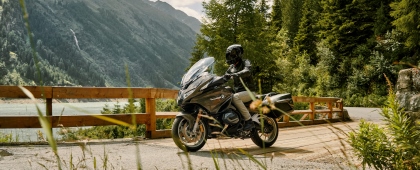 BMW R 1250 RT
BMW R 1250 RT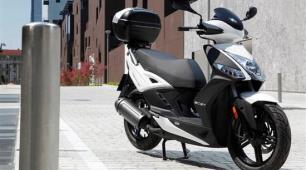 Kymco Agility 50
Kymco Agility 50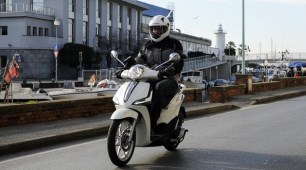 Piaggio Liberty 50
Piaggio Liberty 50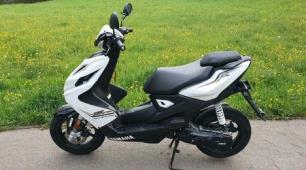 Yamaha aerox NS50
Yamaha aerox NS50 Aprilia SR50R
Aprilia SR50R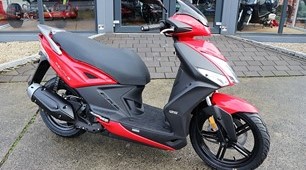 Kymco Agility 50
Kymco Agility 50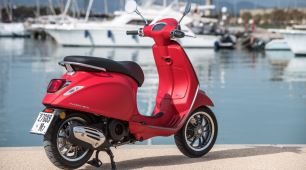 Vespa Primavera 50
Vespa Primavera 50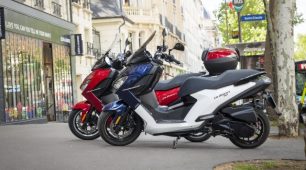 Peugeot Speedfight
Peugeot Speedfight